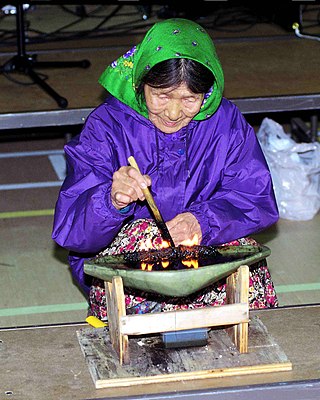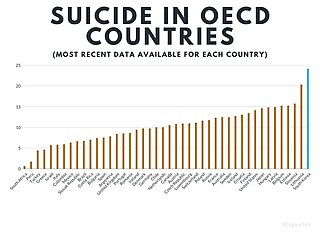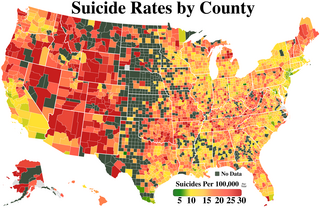Suicide is the second leading cause of death for people in the United States from the ages of 9 to 56.

Suicide prevention is a collection of efforts to reduce the risk of suicide. Suicide is often preventable, and the efforts to prevent it may occur at the individual, relationship, community, and society level. Suicide is a serious public health problem that can have long-lasting effects on individuals, families, and communities. Preventing suicide requires strategies at all levels of society. This includes prevention and protective strategies for individuals, families, and communities. Suicide can be prevented by learning the warning signs, promoting prevention and resilience, and committing to social change.
There are more than 700,000 estimated suicide deaths every year. Suicide affects every demographic, yet there are some populations that are more impacted than others. For example, among 15–29 year olds, suicide is much more prominent; this being the fourth leading cause of death within this age group.
Youth suicide is when a young person, generally categorized as someone below the legal age of majority, deliberately ends their own life. Rates of youth suicide and attempted youth suicide in Western societies and other countries are high. Youth suicide attempts are more common among girls, but adolescent males are the ones who usually carry out suicide. Suicide rates in youths have nearly tripled between the 1960s and 1980s. For example, in Australia suicide is second only to motor vehicle accidents as its leading cause of death for people aged 15 to 25.

Suicide is the act of intentionally causing one's own death. Mental disorders, physical disorders, and substance abuse are risk factors. Some suicides are impulsive acts due to stress, relationship problems, or harassment and bullying. Those who have previously attempted suicide are at a higher risk for future attempts. Effective suicide prevention efforts include limiting access to methods of suicide such as firearms, drugs, and poisons; treating mental disorders and substance abuse; careful media reporting about suicide; improving economic conditions; and dialectical behaviour therapy (DBT). Although crisis hotlines are common resources, their effectiveness has not been well studied.

The Inuit are an indigenous people of the Arctic and subarctic regions of North America. The ancestors of the present-day Inuit are culturally related to Iñupiat, and Yupik, and the Aleut who live in the Aleutian Islands of Siberia and Alaska. The term culture of the Inuit, therefore, refers primarily to these areas; however, parallels to other Eskimo groups can also be drawn.

Suicide in South Korea occurs at the 12th highest rate in the world. South Korea has the highest recorded suicide rate in the OECD. In South Korea, it is estimated to affect 0.02 percent of the population by the WHO. In 2012, suicide was the fourth-highest cause of death. The suicide rate has consistently declined between 2012 and 2019, the year when the latest data are available.

Gender differences in suicide rates have been shown to be significant. There are different rates of suicides and suicidal behavior between males and females. While females more often have suicidal thoughts, males die by suicide more frequently. This discrepancy is also known as the gender paradox in suicide.
World Suicide Prevention Day (WSPD) is an awareness day always observed on 10 September every year, in order to provide worldwide commitment and action to prevent suicides, with various activities around the world since 2003. The International Association for Suicide Prevention (IASP) collaborates with the World Health Organization (WHO) and the World Federation for Mental Health (WFMH) to host World Suicide Prevention Day. In 2011 an estimated 40 countries held awareness events to mark the occasion. According to WHO's Mental Health Atlas released in 2014, no low-income country reported having a national suicide prevention strategy, while less than 10% of lower-middle income countries, and almost a third of upper-middle and high-income countries had.

Suicide is a major national public health issue in the United States. The country has one of the highest suicide rates among wealthy nations. In 2020, there were 45,799 recorded suicides, up from 42,773 in 2014, according to the CDC's National Center for Health Statistics (NCHS). On average, adjusted for age, the annual U.S. suicide rate increased 30% between 2000 and 2020, from 10.4 to 13.5 suicides per 100,000 people. In 2018, 14.2 people per 100,000 died by suicide, the highest rate recorded in more than 30 years. Due to the stigma surrounding suicide, it is suspected that suicide is generally underreported. In April 2016, the CDC released data showing that the suicide rate in the United States had hit a 30-year high, and later in June 2018, released further data showing that the rate has continued to increase and has increased in every U.S. state except Nevada since 1999. From 2000 to 2020, more than 800,000 people died by suicide in the United States, with males representing 78.7% of all suicides that happened between 2000 and 2020. In 2022, a record high 49,500 people died by suicide, while the suicide rate in 2022 reached its highest level since 1941 at 14.3 per 100,000 persons. Surging death rates from suicide, drug overdoses and alcoholism, what researchers refer to as "deaths of despair", are largely responsible for a consecutive three year decline of life expectancy in the U.S. This constitutes the first three-year drop in life expectancy in the U.S. since the years 1915–1918.
China's suicide rates were one of the highest in the world in the 1990s. However, by 2011, China had one of the lowest suicide rates in the world. According to the World Health Organization, the suicide rate in China was 9.7 per 100,000 as of 2016. As a comparison, the suicide rate in the U.S. in 2016 was 15.3. Generally speaking, China seems to have a lower suicide rate than neighboring Korea, Russia and Japan, and it is more common among women than men and more common in the Yangtze Basin than elsewhere.
Suicide is a major national public health issue in the India. 1.71 lakh suicides were recorded in 2022, registering a 4.2% increase over 2021 and a jump of 27% compared to 2018. The rate of suicide per one lakh population has increased to 12.4 in 2022 which is the highest rate of deaths from suicides since 1967, which is the earliest recorded year for this data. Suicides during 2022 increased by 27% in comparison to 2018 with India reporting highest number of suicides in the world. India's contribution to global suicide deaths increased from 25.3% in 1990 to 36.6% in 2016 among women, and from 18.7% to 24.3% among men. In 2016, suicide was the most common cause of death in both the age groups of 15–29 years and 15–39 years. Daily wage earners accounted for 26% of suicide victims, the largest group in the suicide data.
According to the Australian Bureau of Statistics, the age standardised death rate for suicide in Australia, for the year 2019, was 13.1 deaths per 100,000 people; preliminary estimates for years 2020 and 2021 are respectively 12.1 and 12.0. In 2020, 3,139 deaths were due to suicide ; in 2021, 3,144 deaths were due to suicide.

According to the latest available data, Statistics Canada estimates 4,157 suicides took place in Canada in 2017, making it the 9th leading cause of death, between Alzheimer's disease (8th) and cirrhosis and other liver diseases (10th). In 2009, there were an estimated 3,890 suicide deaths.
Suicide in Lithuania has become a significant social issue in the country due to its high rate. Since its peak in 1995, the suicide rate in Lithuania has been constantly decreasing, but as of 2021 it still remains the highest in the EU and the second highest in OECD.

Suicide is a significant national social issue in the United Kingdom. In 2019 there were 5,691 registered deaths by suicide in England and Wales, equating to an average of 18 suicides per day. Suicide is the single biggest killer of men under the age of 45 in the country.

Sweden has a suicide rate which was below the OECD average. During the 1960s, Sweden had one of the highest reported suicide rates among the most developed countries, but it declined as methods for measuring were standardized internationally.
In 2014, the WHO ranked Nepal as the 7th in the global suicide rate. The estimated annual suicides in Nepal are 6,840 or 24.9 suicides per 100,000 people. Data on suicide in Nepal are primarily based on police reports and therefore rely on mortality statistics. However, the burden of suicide in communities is likely to be higher, particularly among women, migrant workers, and populations affected by disasters.
Suicide in Ireland has the 17th highest rate in Europe and the 4th highest for the males aged 15–25 years old which was a main contributing factor to the improvement of suicides in Ireland.
![Map of the suicide rate (age-standardized, per 100,000 population) in the world as of 2010.
.mw-parser-output figure[typeof="mw:File/Thumb"] .image-key>ol{margin-left:1.3em;margin-top:0}.mw-parser-output figure[typeof="mw:File/Thumb"] .image-key>ul{margin-top:0}.mw-parser-output figure[typeof="mw:File/Thumb"] .image-key li{page-break-inside:avoid;break-inside:avoid-column}@media(min-width:300px){.mw-parser-output figure[typeof="mw:File/Thumb"] .image-key,.mw-parser-output figure[typeof="mw:File/Thumb"] .image-key-wide{column-count:2}.mw-parser-output figure[typeof="mw:File/Thumb"] .image-key-narrow{column-count:1}}@media(min-width:450px){.mw-parser-output figure[typeof="mw:File/Thumb"] .image-key-wide{column-count:3}}
.mw-parser-output .plainlist ol,.mw-parser-output .plainlist ul{line-height:inherit;list-style:none;margin:0;padding:0}.mw-parser-output .plainlist ol li,.mw-parser-output .plainlist ul li{margin-bottom:0}
.mw-parser-output .legend{page-break-inside:avoid;break-inside:avoid-column}.mw-parser-output .legend-color{display:inline-block;min-width:1.25em;height:1.25em;line-height:1.25;margin:1px 0;text-align:center;border:1px solid black;background-color:transparent;color:black}.mw-parser-output .legend-text{}
> 30
20 - 30
15 - 20
10 - 15
5 - 10
0 - 5
Data unavailable Map of countries by suicide rate, WHO (2019).svg](http://upload.wikimedia.org/wikipedia/commons/thumb/9/93/Map_of_countries_by_suicide_rate%2C_WHO_%282019%29.svg/365px-Map_of_countries_by_suicide_rate%2C_WHO_%282019%29.svg.png)









